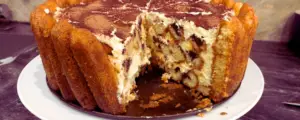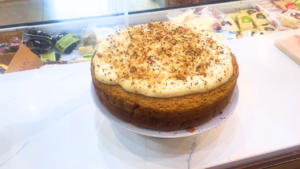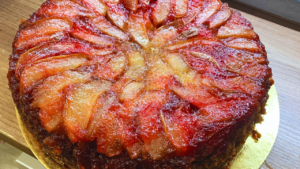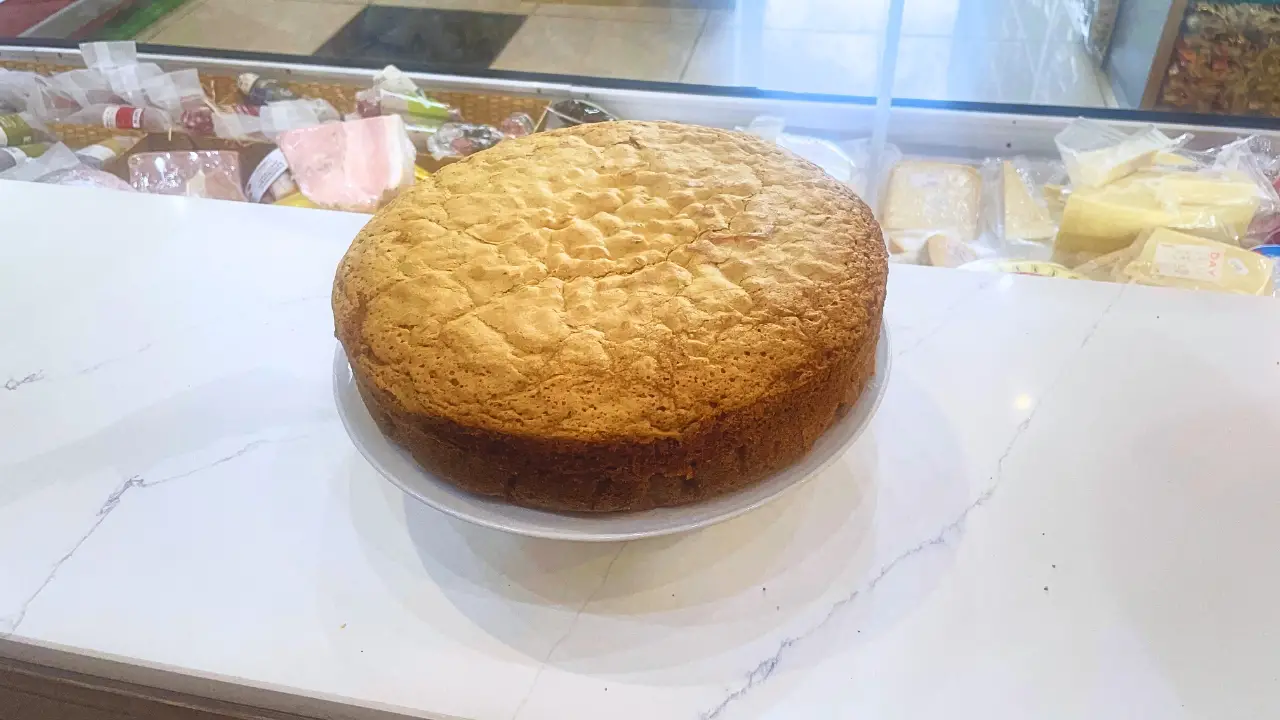Making the perfect sponge cake requires precision and attention to detail. A sponge cake is a light and fluffy cake that is usually made with eggs, sugar, flour, and butter (or vegetable oil). Follow these steps to make the perfect sponge cake:
Ingredients:
- 6 eggs
- 480g granulated sugar
- 420g all-purpose flour
- 1&1/2 tsp baking powder
- 1&1/2 tsp bicarbonate of soda
- 3/4 tsp salt
- 2 tsp cinnamon powder
- 1 tsp vanilla extract
- 380ml sunflower oil
Instructions:
- Preheat the oven to 340°F (165°C) and grease a 10-inch (26-cm) cake pan.
- In a large bowl or food mixer, whisk the eggs and sugar together until pale and fluffy, about 5-7 minutes.
- Sift all the dry ingredients together in a bowl and fold into the egg and sugar mixture add the vanilla extract and mix for a further 5 minutes
- Slowly pour in the sunflower oil and mix for further 3 minutes.
- Pour the batter into the prepared cake tin.
- Bake for 60-70 minutes or until a thin knife inserted into the center of the cake comes out clean.
- Let the cake cool in the pan for 10 minutes before removing it from the pan and placing it on a wire rack to cool completely.
- Once the cake is cool, you can decorate it with whipped cream, fruit, or frosting of your choice.
Enjoy your delicious homemade sponge cake!

Tips for making the perfect sponge cake:
- Use room temperature ingredients to ensure even mixing.
- Be gentle when folding in the dry ingredients to avoid deflating the mix.
- Do not overmix the batter as this will result in a tough cake.
- Use all-purpose flour if using baking powder for a lighter texture.
- Do not open the oven door during baking as this can cause the cake to sink in the middle.
- Once the cake is cool, you can decorate it with whipped cream, fruit, or frosting of your choice.
There are many different recipes but I have always found this one works best.
Questions and answers
Is cake flour better for making sponge cakes?
Cake flour is a type of wheat flour that has a lower protein content than all-purpose flour, making it ideal for making delicate cakes with a tender and light crumb. Sponge cake is a classic example of a cake that benefits from the use of cake flour.
The lower protein content in cake flour means that less gluten is formed when the flour is mixed with liquid. Gluten is the protein that gives baked goods their structure and texture, but too much gluten can make a cake tough and dense. Sponge cake, on the other hand, relies on beaten egg whites for its structure and needs a tender crumb, which is why cake flour is a better choice than all-purpose flour.
Using cake flour in sponge cake results in a cake that is lighter, fluffier, and more tender than one made with all-purpose flour. The texture is more delicate, which allows the cake to absorb the flavors of any accompanying ingredients, such as fruit, whipped cream, or frosting. The cake also has a finer crumb, making it easier to cut and serve without crumbling.
In conclusion, using cake flour is better for sponge cake because it produces a tender, light, and fluffy texture that is essential to a good sponge cake. It creates a delicate crumb that allows the cake to absorb flavors and makes it easier to cut and serve. So, if you want to make a perfect sponge cake, using cake flour is the way to go.
Is sponge cake better with vegetable oil or butter?
Sponge cake is a light and airy cake that relies on whipped eggs for its structure. The choice of fat used in the recipe can affect the final texture and flavor of the cake. Both vegetable oil and butter are commonly used in sponge cake recipes, but which is better depends on personal preference and the desired outcome.
Vegetable oil has a neutral flavor and a high smoke point, which means it can withstand high baking temperatures without burning. This makes it a good choice for sponge cake recipes that require a longer baking time or a higher baking temperature. Using vegetable oil in a sponge cake recipe can result in a cake that is moist, tender, and light. It can also have a slightly denser texture than a cake made with butter.
Butter, on the other hand, has a rich, creamy flavor that can enhance the taste of a sponge cake. It also adds a subtle richness and depth of flavor that can be lacking in a cake made with vegetable oil. However, butter has a lower smoke point than vegetable oil, which means it can burn if the baking temperature is too high. Using butter in a sponge cake recipe can result in a cake that is tender, with a slightly crumbly texture.
In conclusion, the choice of fat used in a sponge cake recipe ultimately depends on personal preference and the desired outcome. Vegetable oil can result in a moist and tender cake, while butter can add richness and flavor. Both can be used to make delicious sponge cakes, but it’s important to follow the recipe and use the fat that is called for to achieve the desired result.

Is caster sugar or granulated sugar better for sponge cakes?
Caster sugar and granulated sugar are two types of sugar commonly used in baking, and both can be used in making sponge cakes. However, the choice of sugar can affect the texture and flavor of the cake.
Caster sugar, also known as superfine sugar, is a finer-grained sugar than granulated sugar. Because the granules are smaller, caster sugar dissolves more easily and quickly than granulated sugar, which can help to create a smooth, even-textured sponge cake. Caster sugar also incorporates more air during the creaming process, which can result in a cake that is lighter and fluffier than one made with granulated sugar. Additionally, caster sugar can give sponge cake a slightly finer crumb.
Granulated sugar, on the other hand, has larger granules than caster sugar, which can make it harder to dissolve completely when creaming with butter. This can result in a slightly denser texture than a cake made with caster sugar. However, granulated sugar can also give sponge cake a slightly crunchy texture, which some people may prefer.
In conclusion, both caster sugar and granulated sugar can be used in making sponge cakes, but caster sugar is often considered the better choice for its finer texture and ability to dissolve more easily. Caster sugar can result in a cake that is lighter, fluffier, and has a finer crumb. However, if you prefer a slightly crunchy texture or don’t have caster sugar on hand, granulated sugar can also be used with good results. Ultimately, the choice of sugar depends on personal preference and availability.
Related posts:
- Tiramisu sponge cake beyond delicious

- Best carrot cake recipe 2023 quick easy & delicious

- Best apple sponge cake moist and delicious

- How to make the perfect sponge cake moist and tasty




One thought on “How to make the perfect sponge cake moist and tasty”